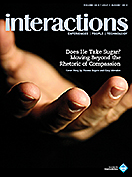Authors:
Anna Vallgårda
How do you describe your lab to visitors? The IxD Lab is a place where we build ideas. It is a space to work with research questions that demand physical exploration of new forms of interactions as well as new materials and computational expressions. We think of it as a form-giving lab, where we give form to computations, materials, and interactions in an ongoing negotiation between the three. The IxD Lab holds basic tools for making physical artifacts, such as a 3-D printer, a laser cutter, sewing machines, and tools for woodwork, textile, print, etc. There is also a basic stock of materials and electronics, such as Arduino boards and shields, various sensors, LEDs, conductive fabric and thread, and thermo chromic ink.
What is a unique feature of your lab? We work as designers with the computer as our primary material. We explore and develop the computer's properties of temporal and interactive form expressed through a variety of compositions with other materials. Some projects stay in the lab as simple form-giving or material experiments; others are put into the field so we can learn more about the interactive gestalts they provoke and the social ramifications of this. Sometimes we also bring the field into the design process in various participatory form-giving processes. Indeed, our setup might not be globally unique, but we are rather unusual in our computer science institution.
How many people are in the lab, and what is the mix of backgrounds and roles? We are up to six people physically sitting in the lab at one time. Currently, we are collecting all the backgrounds we can muster: computer scientists, physicists, textile designers, new media artists, and interaction designers, unevenly divided among the roles of lab manager, associate professor, post doc, Ph.D. students, and lab assistants. Also, we have just moved next to the Pervasive IT lab, and we hope for some spillover effects in the future.
Briefly describe a day in the life of your lab. Some people show up early to take advantage of the quiet mornings; others stay late for the same reasons. But from 10 a.m. to 5 p.m., there is usually a hustle and bustle. Take yesterdaywhile there was a progress meeting for one project in the lounge corner, a group of students came in to get an introduction to the 3-D printer from the lab assistant. Then a dancer and a video journalist came to help out in exploring and documenting an installation running elsewhere in the building. After lunch, one lab member prepared the next morning's lecture on processing. Then a student dropped by, and three of us started to discuss whether he should change his setup from Arduino and sensors to an Android phone for his project with kayaking. Lastly, one person worked a late night trying to revitalize an old project for an upcoming exhibition.
What is the one feature of your lab you would not do without? The most important element of the IxD lab is the space, the physical square meters where we have the elbow room for building stuff and then naturally exchanging ideas, because we are physically there together. Before the lab, we each sat in offices built for classic paperwork and deskwork with our soldering irons and other equipment. We feel like we've been let out of a cage and into our natural habitat.
What is the one feature of your lab that you want and don't have? We only just established the lab in August 2012, so there is still a ton left on the wish list when it comes to equipment. But next in line are a proper wood workbench and a fume cupboard for spray paint, etc. We would also really like a CNC mill.
Describe how people interact in your lab. Well, we laugh a lot, so it is crucial to wear your headphones when trying to concentrate. We have a saying, thanks to our Swedish post doc, Jarmo Laaksolahti, "Aldrig får man vara riktigt glad," which roughly means, "You are never allowed to be completely happy." People who prototype will recognize this sentiment, I am sure. It also fits the bill of an open work environment. It is not the ideal setting for serenity and deep contemplation, but we wouldn't give it up due to the ad hoc knowledge exchange and idea-generating effects.
What is the one thing you see as most important about what you do here? In sum, we strive to create less techno-centric designs while still giving space to the unfolding of possibilities of computational technologies and their derivatives.
Copyright held by author/owner
The Digital Library is published by the Association for Computing Machinery. Copyright © 2013 ACM, Inc.












Post Comment
No Comments Found